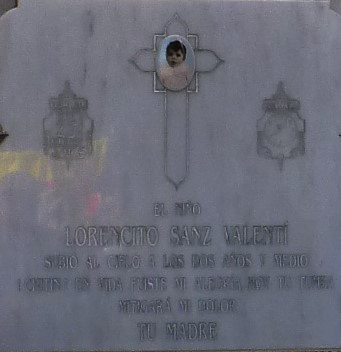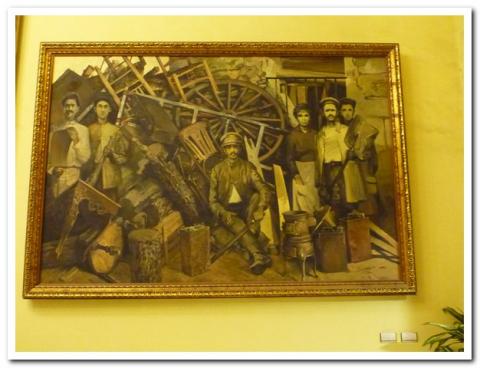International Brigade Memorial Trust
IBMT Trustee Pauline Fraser shares more of her impressions from the recent IBMT-organised group visit to Alicante (see also ‘In Negrín’s final footsteps in Spain’)…
The clock stopped at twenty to twelve
The clock stopped at twenty to twelve on 25 May 1938 for over 300 victims of Mussolini’s air raids. It was a busy market day in Alicante and the fascists knew they would inflict the maximum casualties. This was research for them, research to see how much bombing civilians could take before they cracked. The answer was, those that were left stood firmer and more determined to resist than ever.
But it wasn’t research for the victims. After the war, one family erected a memorial plaque to their two-and-a-half year old toddler, Lorencito Sanz Valenti, killed with his grandfather in the bombing, and left coded messages for posterity. On the right, above the tiny child’s picture, is a clock showing the time of the bombing – twenty to twelve. The arms of what looks like a cross surround the picture, but on closer examination are found to be bombs. The memorial has been replaced, but on the original, tail fins had been sculpted by the stone mason at the foot of the cross, making the meaning crystal clear.

The citizens of Alicante must have been proud of their fine new market building, designed in modernista style, and opened in 1921. It was reduced to rubble on 25 May and had to be completely rebuilt.
Set in the pavement outside the market is a fine new memorial inaugurated on 25 May 2013, exactly 75 years after the bombing, by the Civic Commission for the Recovery of Historical Memory. It consists of nine steel squares, each one representing a fascist bomber. There are 16 symmetrical black dots within each square, representing the number of bombs dropped by each plane. Scattered across the memorial are 300 red pinpoints of light, each one representing a victim. One of those lights is for little Lorencito.
Alcoy’s revolutionary history
During a reception at Alcoy Town Hall, my attention was drawn to two paintings by Ramón Castañer Segura which hang in pride of place on the staircase leading to the council chamber. One depicts workers on the barricades, the other shows the body of the murdered mayor being dragged through the streets, legs first.
I discovered that Alcoy has a revolutionary history as dramatic as its setting, sitting astride a deep gorge. The valleys around the town are littered with decaying watermills, bearing testimony to its early industrialisation. The main industries during the 1870s were textiles and paper. Conditions for the 10,000 men, women and children who worked in the factories were appalling, with 42 per cent of children dying before their fifth birthday.
In July 1873, following the proclamation of the First Republic, a general strike was called. Workers demanded higher wages and a reduction in the day from 12 hours to 8. Furthermore, they demanded that Albors, the mayor, resign, to be replaced by a revolutionary junta. While waiting for the result of talks, Albors ordered the municipal guard to fire on the crowd to disperse them. One person was killed and several wounded. Workers then took up arms and burnt down a number of factories, and the town hall, where Albors had sought refuge, killing the mayor.
At the outset of the Spanish Civil War the main factories were taken into communal ownership. Textile factories produced uniforms, iron and steel mills were turned over to building tanks and other war materiel and paper mills to producing posters and leaflets. The citizens set to constructing communal air-raid shelters and we visited Refugio Cervantes, which had been built for the schoolchildren of the neighbouring school.
Not only was Alcoy an important part of the Republican war effort, but the hydroelectric plant that powered the factories also supplied electricity to an infantry barracks and two railway stations, thus making the town an obvious target for bombing.
It was bombed on seven occasions by Savoia SM-79 bombers based in Mallorca. The bombing claimed the lives of 52 people, but casualties were minimised thanks to the extensive system of air-raid shelters.

